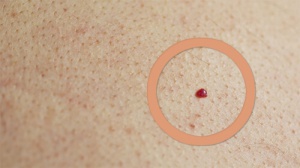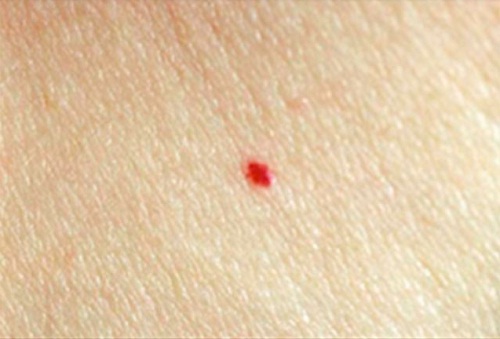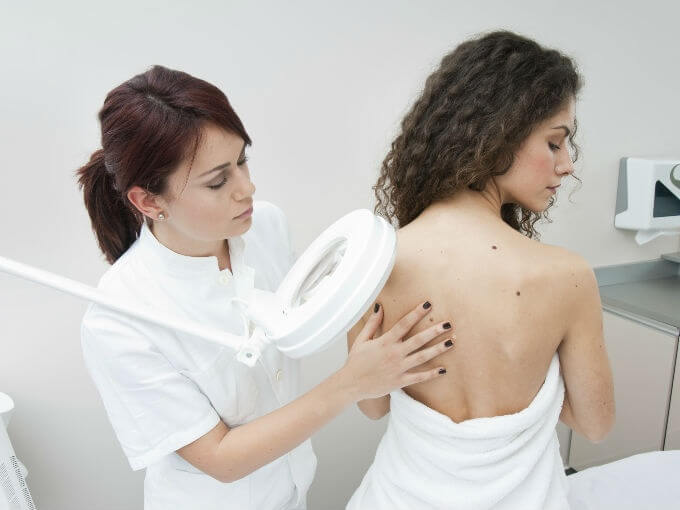What Causes Cherry Angiomas?


Written and verified by psychologist Valeria Sabater
These small marks are an intense, scarlet red. It’s usually a bit scary when you first notice one on your skin. They don’t hurt, but they’re kind of ugly, and most people don’t know what causes cherry angiomas to appear out of nowhere. Is it diet? A disease? We should start by saying they’re not serious, though you do need to control them. Read on.
What causes cherry angiomas?
- Some people think of these kinds of marks as an attractive, unique touch to their skin. But you do have to keep them in check. Cherry angiomas also have a couple other names: Campbell De Morgan spots and senile angiomas. They’re especially common for middle-aged people and people with extremely pale skin.
- Like we said, they’re not usually dangerous, but if a lot of them appear suddenly, you should see a doctor because there’s definitely something going on in your body. Experts associate them with liver problems.
- They can also be caused by a poor diet, which builds up too many toxins in your intestines or liver.
- What causes cherry angiomas is an abnormal growth of small blood vessels.
- They measure between 1 and 4 millimeters. You may have these red moles in places like your underarms, heels, genital areas, chest, back, legs, arms…
- Cherry angiomas on your face, hands, and other exposed parts of your body can be from overexposure to the sun. You should be cautious if that’s the case.
- Look at the edges and texture. If they’re irregular, coarse, and measure more than 6 millimeters, you’ll need to speak to your dermatologist too.
- Watch out for them in children too. Children with very light skin can also get these red birthmarks. Check them every so often to make sure they don’t have any cherry angiomas.
- They’re often hereditary.
- They can also appear because of minor hormonal disorders in women.
- They also appear with age.
You might like:
Diagnosis
If you get a cherry angioma on your skin, the first thing is to not get scared because they aren’t serious and don’t tend to need any treatment. But you should follow these:
- See a doctor if many appear on your thorax. One or two aren’t a big deal, but suddenly having any more above this number might signal a health problem.
- Check to see if the moles are asymmetrical or symmetrical in shape. If you have any that are asymmetrical, see a doctor.
- Look at the color. If it stays red it’s not a problem, but if it turns darker and darker, you should tell your doctor.
Read more:
The 5 Worst Lies You Can Tell Your Doctor
Treatment and prevention
- Experts say that to stop these red birthmarks from appearing and reduce their impact, you should cleanse your intestines and strengthen your liver.
- Try to drink at least two liters of water a day.
- Eat plenty of fresh vegetables and drink lots of juice. It’s especially good to eat carrots, artichokes, and celery.
- Spirulina algae, for example, is perfect for absorbing toxins in the intestines.
- Make avocados and olive oil a part of your diet.
- Start your morning with a glass of lemon juice.
- Dink at least two glasses of juice a day (cranberry, pineapple, pomegranate).
- Avoid dairy products. Replace them with a plant-based milk.
- Drink a dandelion infusion once a day. It’s very depurative.
- Besides having a balanced diet, the best way to prevent cherry angiomas is to protect yourself from the sun. You can use sunscreen to prevent the ones that appear on your face and neck. Always try to keep your skin hydrated, get plenty of vitamin C, and avoid being in the sun at the hottest times of the day.
- Cherry angiomas generally don’t go away. If they bother you, you can use more traditional natural remedies, like applying a bandage with onion juice every day until they go away. Another option is to consistently take vitamin C supplements.
- At the end of the day, our best tip to prevent them is to maintain a balanced diet. This will keep toxins from building up in your body, and your skin will be grateful for it.
So, now that you know what causes cherry angiomas and what you can do to prevent them, why wait? Following these tips will be great for your overall health, too!
All cited sources were thoroughly reviewed by our team to ensure their quality, reliability, currency, and validity. The bibliography of this article was considered reliable and of academic or scientific accuracy.
- https://cuidateplus.marca.com/belleza-y-piel/cuidados-cuerpo/2019/08/12/aparecen-puntos-rojos-parecen-lunares-170710.html
- https://hoy.com.do/mitos-y-realidades-sobre-los-lunares-rojos-en-la-piel/
- https://www.correofarmaceutico.com/tododermo/cuidados-de-la-piel/por-que-aparecen-puntos-rojos-similares-a-los-lunares.html
- Sanitas: Puntos rojos en la piel ¿Por qué salen?. https://muysaludable.sanitas.es/salud/puntos-rojos-la-piel-salen/
This text is provided for informational purposes only and does not replace consultation with a professional. If in doubt, consult your specialist.











